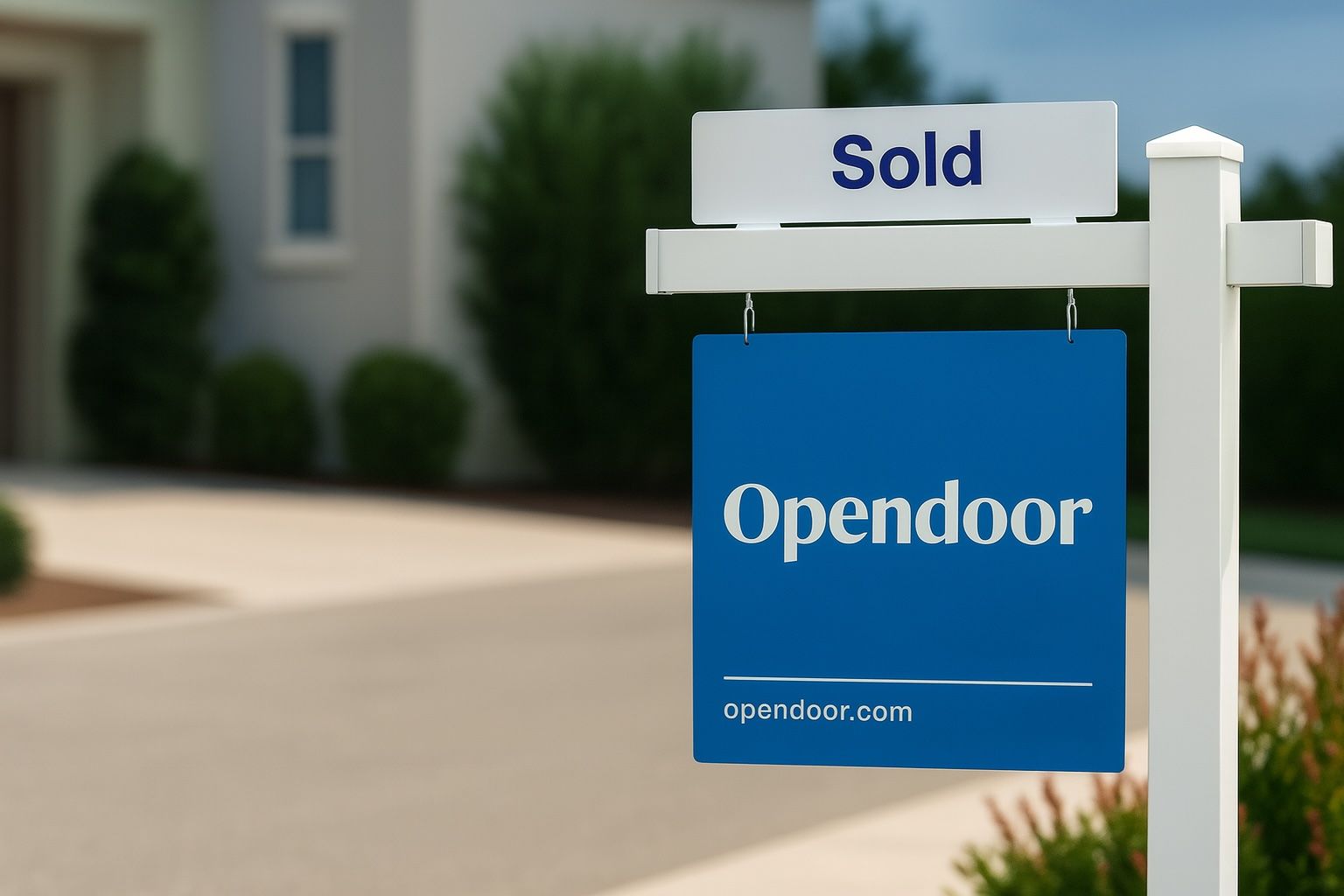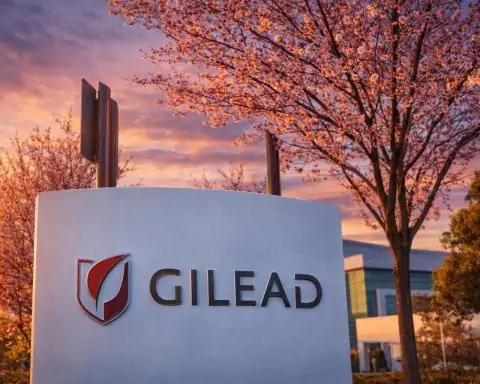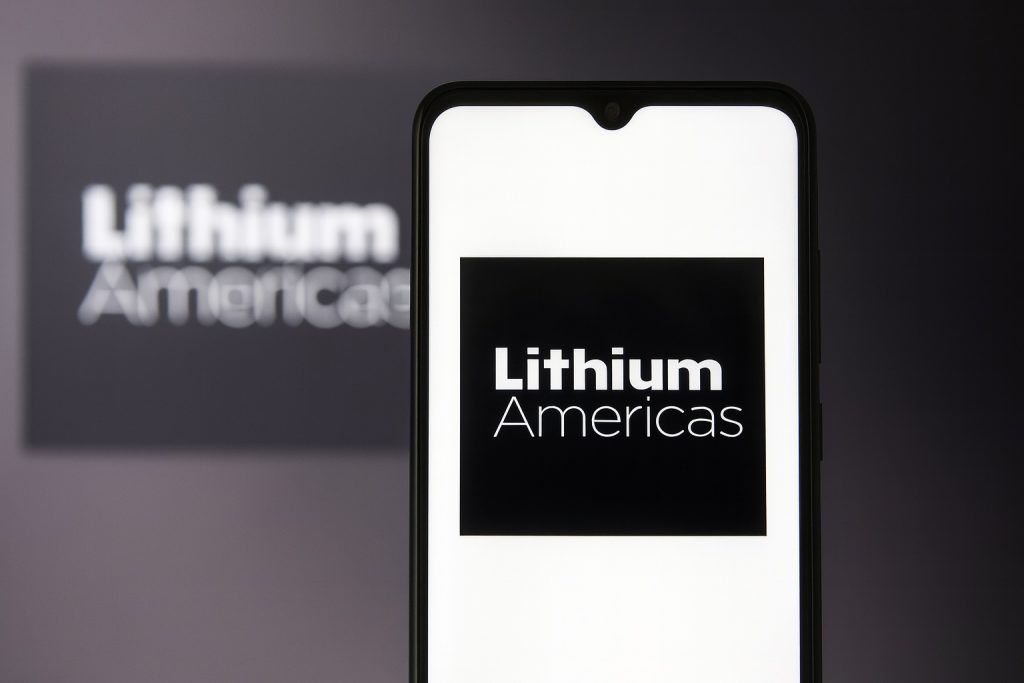- Current Price: As of Oct. 3, 2025 mid-morning, Opendoor (NASDAQ: OPEN) trades around $8.56, up about 6.8% on the day [1]. The stock opened at $8.01 (prior close) and has swung between roughly $7.93–$8.14 early today [2]. OPEN is up ~401% year-to-date [3] as investors cheer new leadership and AI-driven initiatives.
- Recent Spike: The stock has “staged a massive comeback, soaring 450% year to date” [4], driven by enthusiasm over new CEO Kaz Nejatian (formerly Shopify COO) and aggressive expansion plans [5] [6]. Co-founder and investor Keith Rabois has also joined the board, helping fuel the rally [7] [8].
- Q2 2025 Results: In Q2 (ended June), Opendoor delivered revenue of $1.57–$1.60 billion and a $23 million positive adjusted EBITDA – its first quarterly EBITDA profit since 2022 [9]. Net loss narrowed sharply to about $29M. The company sold 4,299 homes in Q2, with a gross profit of $128M (8.2% margin) [10]. Management also authorized a $200M share buyback for Q3, signaling confidence [11]. However, management issued weak Q3 guidance (revenue $0.8–0.875B vs. ~1.5B consensus), which sent the stock down ~11% after the Q2 release in August [12] [13].
- Leadership Changes: On Sept. 10, 2025, Opendoor named Shopify executive Kaz Nejatian as CEO and board member [14]. He replaced Carrie Wheeler (who resigned Aug. 15) [15]. Co-founders Keith Rabois and Eric Wu returned to the board (Rabois as chairman) to inject “founder DNA” [16]. In announcing the hires, Nejatian stressed AI’s role: “Few life events are as important as buying or selling a home. With AI, we have the tools to make that experience radically simpler, faster and more certain” [17]. Rabois praised Nejatian as a “decisive leader” whose background in AI and cost-cutting will “unlock Opendoor’s unique data” [18].
- Expert Quotes: In public commentary, CEO Nejatian teased that Opendoor is “close to shipping a relatively big change” in the product, with a software update imminently rolling out [19]. Board chair Keith Rabois echoed confidence in the company’s plan, responding on social media “Yes [breakeven by 2026 is possible] … but won’t have an actual plan or forecast to share until earnings” [20]. (Rabois’s comment suggests management targets profitability within a year, but will reveal details at the next earnings call.)
- Analyst Outlook: Wall Street analysts are divided. Many remain skeptical, citing thin profit margins and a difficult housing market. The average 12-month price target is only about $1.26 (down ~86% from current levels) [21], reflecting bearish sentiment. Price targets among brokers range from ~$0.70 to $2.00 [22]. (Notably, Deutsche Bank’s Benjamin Black recently cut his OPEN target to $1.35, “Hold” [23].) In contrast, some growth-focused analysts remain optimistic. For example, JPMorgan reaffirmed a “Buy” rating on Sept. 10, 2025 (with a higher target, according to reports), praising Nejatian’s tech experience. Independent observers note that Opendoor now holds a “dominant position in the iBuyer space” and “could disrupt real estate at scale” [24]. Overall, expert forecasts diverge sharply: conservative targets imply steep downside, while hype around AI and new strategy drives bulls to bet on further gains.
- Industry Context (iBuyer/Real Estate): Opendoor is a leading iBuyer, a model where a company uses data algorithms to make instant offers on homes. The iBuyer concept boomed mid-2010s but has seen mixed success. Zillow and Redfin both ended their iBuyer programs (Zillow Offers shut down in 2021, RedfinNow in 2022) [25]. Today Opendoor and Offerpad are the largest iBuyers. Offerpad (founded 2015) operates in 9 states and is similar in scope [26]. The broader U.S. housing market is currently muted: mortgage rates are in the mid-6% range (down slightly from earlier highs) [27], inventory has ticked up (roughly 15–20% more homes on market vs. last year) [28], and home sales are at multi-decade lows [29]. This means more competition for homebuyers but also softer home-price growth (national prices are roughly flat year-over-year [30]). For iBuyers, slower transaction volume and tighter margins are risks, though easing rates and inventory give more running room.
Company Fundamentals & Business Model
Opendoor makes money by buying homes with an algorithmic price offer and reselling them to consumers or investors. Its strength is a large proprietary dataset and instant-offer platform, but it carries risks (inventory carrying costs, model accuracy). After struggling to generate cash flow early on, Opendoor is emphasizing profitability: it achieved positive adjusted EBITDA in Q2 [31] and promises to get to breakeven by 2026. In Q2 the gross profit per home sold was $128M/4,299 ≈ $30k on average; earlier quarters had similar per-home profits. (Management has said Q1 gross profit per home was ~$16k [32].) At the end of Q2, inventory of unsold homes was ~$1.5B (≈4,538 homes) [33], which it will need to unload. Opendoor also pointed to tight expense control, and it has cut staff (40 layoffs announced in June 2025 [34]) and lowered capex guidance as margins improve [35]. The company’s 2025 full-year revenue is now expected around $5–6B (well below earlier plans), with profitability hinging on cost cuts and any rebound in home sales. Founder Eric Wu (co-chair) and investor Keith Rabois are pushing an “AI-first” strategy to improve pricing and operations – a long-term opportunity, but one that requires upfront investment and carries execution risk.
Recent News & Developments
In addition to the CEO shake-up, a few other recent items stand out. In mid-June 2025 Opendoor agreed to settle a 2022 investor lawsuit for $39 million [36]. The suit alleged Opendoor misled investors by overstating the sophistication of its pricing algorithms [37]. Opendoor denied wrongdoing but chose to settle to avoid litigation. (The settlement was reported by Reuters and HousingWire [38] [39].) The company has also disclosed insider buying: notably, co-founder Eric Wu purchased about $2 million of stock at ~$6.65 per share in late Sept. 2025, boosting his total stake to ~1.95M shares [40]. Meanwhile, market data firm Jane Street revealed in mid-Sept. that it took a 5.9% stake in Opendoor (over 44M shares) – a rare splash by a quantitative investor in a single company. These developments suggest confidence from insiders and quants that Opendoor may rebound. One more data point: Opendoor offered a $200M Q3 buyback in early Aug [41], and CEO Nejatian’s teaser of new product changes on Oct. 2 [42] has kept traders buying today.
Analyst Forecasts & Price Targets
Consensus forecasts remain cautious. MarketBeat reports 5 covering analysts with an average 12-month target of just $1.26 [43], far below today’s price. (The highest target in the group is only $1.75; the lowest just $0.70 [44].) In short, many analysts see virtually all of today’s gain as overvaluation. For example, Deutsche Bank cut its PT to $1.35 (Hold) in Feb. 2025 [45], and Goldman Sachs and others have price targets in the $1–$2 range. On the other hand, some growth-oriented analysts have turned bullish on the leadership change. JPMorgan, for instance, reiterated a Buy rating around Kaz Nejatian’s hiring, citing his ability to “sharpen product focus and execution” (per industry media) [46] [47]. Motley Fool’s Rick Orford notes the 450% run-up and argues that “with a new CEO, bold national expansion plans, and a dominant position in the iBuyer space, the company could disrupt real estate at scale.” [48]. However, even bulls caution that Opendoor must still prove its path to profit. Overall, analysts’ revenue/earnings forecasts remain modest: for FY2025 Wall Street models see Opendoor near breakeven (consensus call: revenue ~$5–6B, EPS around $0) after prior losses. If Nejatian can restore growth or sustain margins, forecasts may rise – but for now most targets imply a sharp pullback.
Real Estate Market & iBuyer Industry
The U.S. housing market is currently soft. Mortgage rates (30-year fixed) have eased into the mid-6% range [49], which is lower than summer’s 7%+ peak but still historically high. Inventory has finally grown: ~15–20% more homes are on the market than a year ago [50], and prices have largely flattened (even slight declines in some areas) [51]. Existing-home sales are at a 30-year low (~4 million annual rate) [52] as many homeowners hold low-rate mortgages. For Opendoor, this means both challenge and opportunity: slower market activity can squeeze its flip margins, but more available homes give it something to buy and improved negotiating power (buyers can price more aggressively).
Within this market, Opendoor operates as an iBuyer – a category of companies offering quick, algorithm-driven cash offers on homes. Early entrants Zillow and Redfin both exited this business (Zillow Offers ended in 2021, RedfinNow in 2022) [53] after heavy losses. That leaves a narrower field: Opendoor and Offerpad are the largest active iBuyers today. Offerpad (founded 2015) sells homes in ~9 states and similarly promises cash offers in 24 hours [54]. (Unlike Zillow/Redfin, Offerpad remains private but is understood to be profitable in some markets.) Other competitors include smaller iBuyer teams or hybrid services, but Opendoor is generally seen as the industry leader given its volume and brand. One indirect competitor is the traditional real estate brokerage model: some sellers choose to list conventionally or use “guaranteed offers” from brokerages, rather than sell quickly to an iBuyer. Overall, while iBuying has not (yet) overhauled home sales, Opendoor’s scale gives it an advantage over smaller rivals – but it also means it now has a target on its back if the housing market falters.
Risks and Opportunities
Opportunities: The biggest upside is execution of Opendoor’s new strategy. Kaz Nejatian’s AI/tech expertise and the return of founder oversight could improve home pricing algorithms and cost management. If Opendoor refines its model to price homes faster and more accurately, it could achieve higher take-rates and profits. The new CEO has signaled a deeper “AI-first” pivot [55], which some investors hope will widen margins or open new services (e.g. AI-driven buyer/seller recommendations). The company’s strong balance sheet (over $1B cash after Q2) and $200M buyback plan [56] also provide runway for growth or stock support. Insider buying (Eric Wu’s $2M purchase [57]) and large institutional stakes (Jane Street) are bullish signals that might attract momentum investors.
Risks: Key risks include the weak housing cycle and competition. High rates and economic uncertainty mean lower volumes of home sales, which could continue to drag on Opendoor’s top line. Its Q3 guidance (set in August) already assumes far fewer transactions than in 2024 [58]; any slower recovery could further hurt revenue. Operationally, profit margins are slim: in Q2 the take-rate was only ~8%. Any error in price assumptions can turn a sale into a loss. Although the pricing-algorithm lawsuit was settled, such litigation highlights investor skepticism about Opendoor’s “edge.” Management also warned of inventory risks: unsold homes sitting for too long can incur finance and maintenance costs. With the stock now well above pre-surge levels, valuation is a risk – if Opendoor fails to show concrete improvements soon, traders may sell aggressively (as seen in the 10–15% pullback after the CEO news frenzy).
Competition: Offerpad remains the chief competitor; it often matches Opendoor’s reach by buying in similar markets [59]. Rival iBuyers may try to steal market share with better offers or tech. In addition, some fintech or real estate startups could emerge (for example, companies pairing iBuying with mortgage services). Any move by large firms (e.g. another SPAC or tech firm entering real estate) could also reshape competition. Finally, Opendoor’s closest benchmark, Zillow (ZS), still has a real-estate listings business and could potentially re-enter iBuying in a limited way if market conditions change.
Summary: Opendoor sits at a crossroads. Its stock is buoyed by new leadership and a long-awaited return to profitability [60], yet fundamentals remain modest. As of early Oct. 2025, OPEN’s real-time price reflects the market’s mixed view: bullish excitement over an AI-driven turn-around [61] [62] versus bearish caution that current momentum far outstrips underlying performance [63] [64]. For investors, the key question is whether Opendoor can deliver on its promises. A smooth summer in the housing market or a stroke of AI innovation could lift the stock higher; setbacks or continued guidance cuts could reverse much of the recent gains.
Sources: Company filings and press releases; earnings transcripts (Q2 2025); Reuters, HousingWire, RISMedia and financial news articles [65] [66] [67]; stock market data sites [68] [69]; analyst and industry reports [70] [71] [72]. These cited sources provide all factual details above.
References
1. stockanalysis.com, 2. stockanalysis.com, 3. stocktwits.com, 4. www.nasdaq.com, 5. www.nasdaq.com, 6. www.rismedia.com, 7. www.rismedia.com, 8. stocktwits.com, 9. mlq.ai, 10. mlq.ai, 11. mlq.ai, 12. mlq.ai, 13. 247wallst.com, 14. www.rismedia.com, 15. www.rismedia.com, 16. www.rismedia.com, 17. www.rismedia.com, 18. www.rismedia.com, 19. stocktwits.com, 20. stocktwits.com, 21. www.marketbeat.com, 22. www.marketbeat.com, 23. www.tipranks.com, 24. www.nasdaq.com, 25. www.homelight.com, 26. www.homelight.com, 27. www.empirelearning.com, 28. www.empirelearning.com, 29. www.empirelearning.com, 30. www.empirelearning.com, 31. mlq.ai, 32. 247wallst.com, 33. mlq.ai, 34. www.housingwire.com, 35. 247wallst.com, 36. www.reuters.com, 37. www.reuters.com, 38. www.reuters.com, 39. www.housingwire.com, 40. stocktwits.com, 41. mlq.ai, 42. stocktwits.com, 43. www.marketbeat.com, 44. www.marketbeat.com, 45. www.tipranks.com, 46. www.nasdaq.com, 47. www.nasdaq.com, 48. www.nasdaq.com, 49. www.empirelearning.com, 50. www.empirelearning.com, 51. www.empirelearning.com, 52. www.empirelearning.com, 53. www.homelight.com, 54. www.homelight.com, 55. www.rismedia.com, 56. mlq.ai, 57. stocktwits.com, 58. 247wallst.com, 59. www.homelight.com, 60. 247wallst.com, 61. www.rismedia.com, 62. www.nasdaq.com, 63. www.marketbeat.com, 64. 247wallst.com, 65. www.reuters.com, 66. www.housingwire.com, 67. www.rismedia.com, 68. stockanalysis.com, 69. stocktwits.com, 70. mlq.ai, 71. www.marketbeat.com, 72. www.homelight.com







